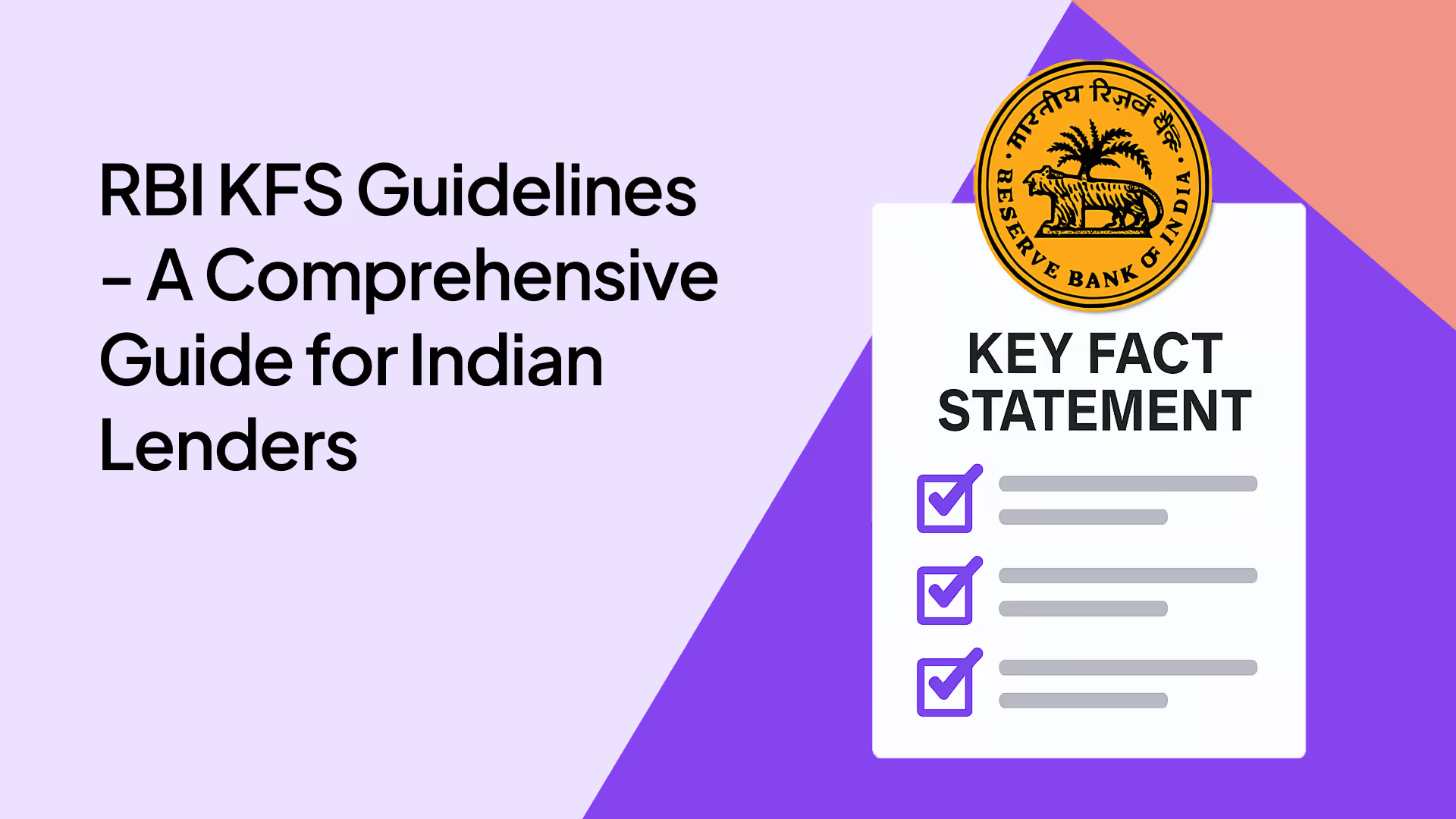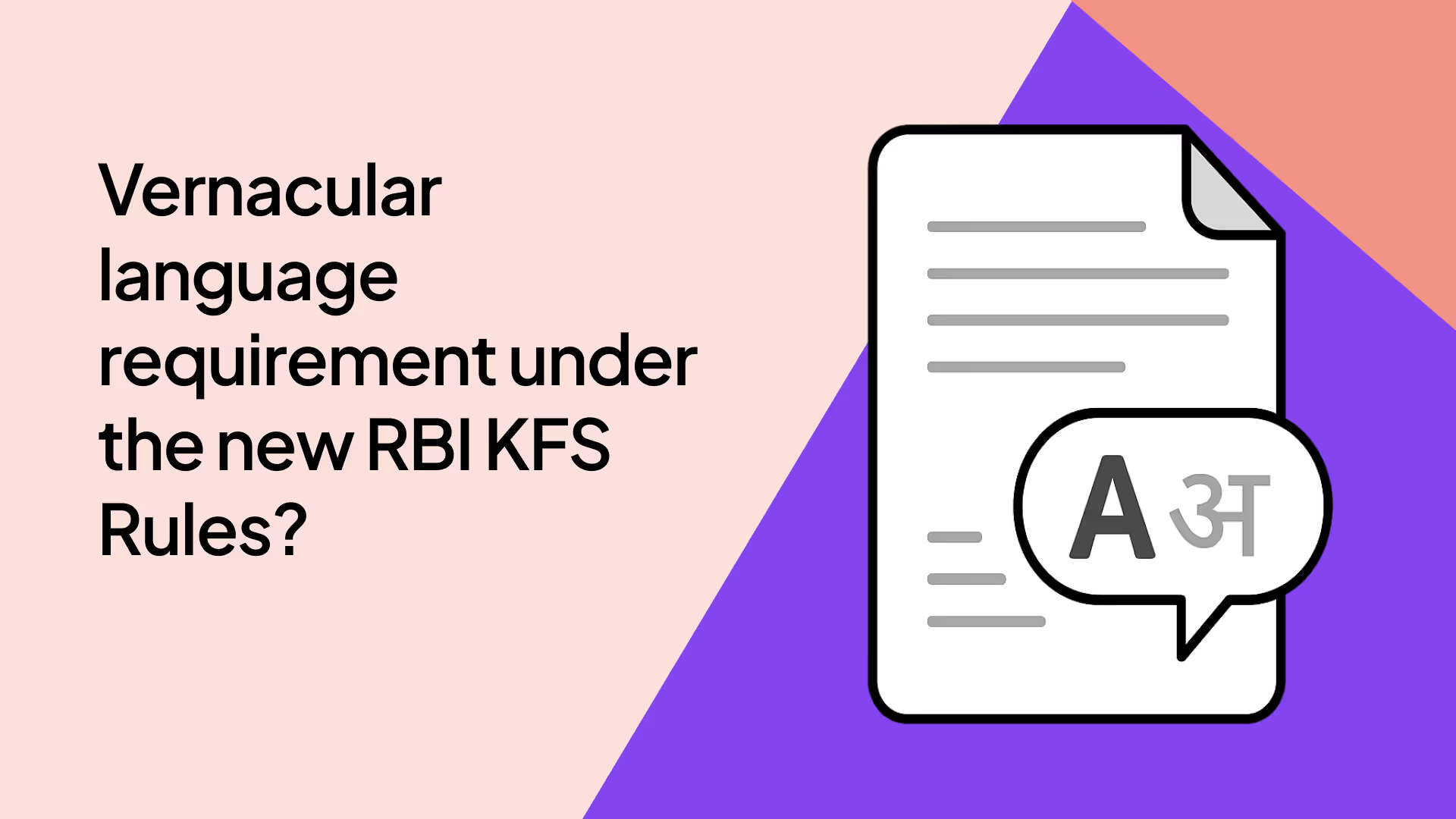On Apr 15, 2024, the Reserve Bank of India (RBI) introduced a fresh set of guidelines about Key Fact Statements ("new KFS Rules", "Guidelines", "Rules")
These rules override previous guidelines on Key Fact Statements - effectively becoming the new “law” on Key Fact Statements in India.
Given the importance and urgency of these guidelines for Indian lenders, we have written this comprehensive guide. If you are an Indian Bank, NBFC or fintech company that wants to comply with these guidelines then this guide will be useful for you.
I don’t have time to read this entire guide, can you give me a summary of the new KFS rules that I can read in 2 minutes?
While we recommend that you read the entire guide, here is a quick summary of the key changes introduced by the RBI Key Facts Statement (KFS) guidelines:
- KFS is mandatory for MSME and Retail Loans: The rules reiterate that KFS is mandatory for all MSME and retail term loan products. There is a specific exception carved out for credit card products.
- Standardized Format: A specific standardized format for KFS and its attachments has been provided by the RBI in Annexure A, B and C of the rules. You will need to update your KFS to this format. If you don't have a KFS in your retail and MSME loan workflows, then you will need to start including one.
- Local Language: The RBI has now included a mandatory requirement to provide the KFS in a language understood by the borrower to enhance accessibility.
- Borrower Acknowledgement: Lenders are required to obtain an acknowledgment from borrowers that they have understood the KFS, ensuring informed consent. This acknowledgement must be obtained before the loan agreement is sent to the borrower
- KFS to be included in loan agreement: The KFS needs to be included in the loan agreement as a summary box
- Amendments to Loan Terms need explicit borrower consent: Any deviation from the terms outlined in the KFS in the final loan agreement is prohibited. For any changes during the loan term, lenders will need to collect explicit consent from the borrower.
- Borrowers are entitled to an evaluation period before they sign the KFS: Borrowers are entitled to a period of at least 3 days to consider if they want to accept/reject the terms of the loan (for loans with tenure greater than a week). For loans with tenure less than a week borrowers are entitled to 1 day to consider.
These updates aim to strengthen the information framework for borrowers, ensuring they receive and understand all necessary details to make an informed decision about whether to take a loan or not.
What entities do the RBI KFS Guidelines apply to?
The new KFS Rules apply to the following entities:
- All Commercial Banks (including Small Finance Banks, Local Area Banks and Regional Rural Banks) but not Payments Banks
- All Primary (Urban) Co-operative Banks, State Co-operative Banks and Central Co-operative Banks
- All NBFCs (including HFCs and MFIs)
If you are not any of the above entities then you can stop reading here - unless you are a fintech operating a digital lending application. In which case you should read the next question.
I am a fintech application operating a digital lending application. I am not an NBFC - but my customers can avail loans through my Bank/NBFC partners via my application. Do these guidelines apply to me?
In a legal sense the answer is NO. You are not directly responsible for these guidelines.
But in a practical sense - YES - you should take note of these guidelines.
Why?
Ultimately, if you control the front-end customer experience for the lending journey - then RBI will also question you if that journey is not compliant.
So while the lending journey will technically be that of the lending partner - you can come under RBI crosshairs if your lending partner’s journey is not compliant.
Do the new RBI KFS Rules apply to all types of loan products?
No. The Rules are applicable in cases of retail and MSME term loan products.
Here is an extract from Clause 2 of the rules which states this:

The Rules also make an explicit exception for credit card receivables:

So these guidelines will not be applicable to credit card products or wholesale loan products where the borrower entity is NOT an MSME.
What must be included in the KFS?
The guidelines now prescribe a specific format for the KFS.

This format is contained in Annexure A to the Rules.
We have attached it here below for you to view and download:
We have also extracted the information you need in Annexure A here:
Part 1: Key Quantitative Information
This part includes the essential quantitative details that define the financial terms of the loan:
- Loan proposal/account No.
- Type of Loan
- Sanctioned Loan amount (in Rupees)
- Disbursal schedule (including stages and related clauses if not disbursed 100% upfront)
- Loan term (specified in years, months, or days)
- Installment details (type, number, amount of EPIs, and commencement of repayment)
- Interest rate (percentage and type: fixed, floating, or hybrid)some text
- Additional floating rate information: Reference Benchmark, Benchmark rate, Spread, Final rate, Reset periodicity, Impact of benchmark change on EPI and number of EPIs
- Fees/Charges (payable to the RE, payable to a third party through RE, including specifics like processing fees, insurance charges)
- Annual Percentage Rate (APR) (expressed as a percentage)
- Details of Contingent Charges (penal, foreclosure, switching charges, etc.)
Part 2: Key Contractual Clauses
This section highlights critical clauses that are usually buried deep in the loan agreement, ensuring that borrowers are aware of key procedural and operational terms:
- Clause of Loan agreement relating to engagement of recovery agents
- Clause detailing grievance redressal mechanism
- Contact details of the nodal grievance redressal officer (phone number and email)
- Information on potential transfer of the loan to other REs or its securitization
- Details related to collaborative lending arrangements: Names and proportions of funding by the originating and partner REs, blended interest rate
- Specific disclosures for digital loans:some text
- Cooling off/look-up period
- Details of the LSP acting as a recovery agent
The KFS will also need to contain a computation sheet of the APR and amortization schedule. The RBI has provided a format for both in Annexures B and C.
We have produced them here for you to view and download:
Annexure B PDF
Annexure C PDF
When must the KFS be provided to the borrower?
Clause 4 of the Guidelines state:

In the market, we have seen lenders adopt one of two approaches:
- Watertight Approach: KFS must be sent to the borrower and acknowledged before the loan agreement is sent to the borrower. This means that KFS and loan agreement will not be part of the same document kit. The execution process will need to happen twice. This approach is 100% compliant with the new KFS Rules - and is being followed by most of the Banks and NBFCs that we work with
- Liberal Approach: KFS can be sent to the borrower as part of the loan kit. But it must be acknowledged explicitly by the borrower while executing the entire document kit. If it is part of the loan kit then it needs to be the first document chronologically in the kit. No one is fully sure whether this approach is compliant or not - since one could argue that getting KFS acknowledged at the same time as signing of loan agreement would not be a case of "KFS before loan agreement". This approach may be violative in spirit of the new KFS rules.
You can read more about this requirement in detail in our full article - When does the KFS need to be signed?
Is there a set validity period for the KFS?
To answer this question, look at Clause 5 of the Rules:

Basically:
- For loans with tenure of 7 days or more => The KFS will have a validity period of at least three working days
- For loans with tenure of less than 7 days => The KFS validity period will be at least one working day
The validity period will be calculated from the date on which the KFS has been provided to the borrower.
The validity period provisions are made purely from a borrower protection perspective. It is a minimum period of time that the borrower is entitled to for accepting or rejecting the KFS. You can give the borrower more time also if you want - the rules do not prevent that.
So I can only execute the loan agreement and disburse the loan after 3 days of providing KFS?
Not quite. The rules do not expressly state that the borrower can only accept or reject after 3 working days of provision of KFS.
Instead, the guidelines merely state that the borrower is entitled to three working days to accept or reject the loan.
Practically, this means that the borrower can choose whether they want to execute the KFS and loan agreement on the same day on which they receive the KFS or if they want to take 3 days to think about it.
There are 2 scenarios here:
- If the borrower chooses to take 3 working days, then the lender has no choice but to wait. The lender can also offer more time to the borrower if they want.
- If the borrower chooses to execute on the same day itself - that is also fine.
Does the KFS need to be in a local Indian language?
Yes.
Have a look at Clause 4 of the Guidelines again:

The clause clearly stipulates that the language of the KFS must be understood by the borrower.
Here’s the data on language in India:

So, in short, the KFS template cannot just be in English - especially for retail loans. It needs to be in a local language. This is especially important for micro-loans and rural farm loans.
To truly imbibe the spirit of this requirement - any consent collected from the customer/borrower outside the KFS but during the KFS signing journey i.e eSign consent - would also need to be in a local language.
So you need a localized document and a localized execution interface to comply with this requirement.
You can read more about this specific requirement in our detailed article about the new KFS Rules' vernacular language requirement.
But I don’t have the ability to get language fluency data for each borrower - how can I comply with this?
Great question. There is no actual way to get fluency data for each borrower. In many places - like metros - your borrower pool consists of different language fluencies. So how do you ensure that your KFS is in a local language understood by the borrower?
For the document kit:
For the actual KFS document, you will need to actually send a “KFS Kit” which contains the KFS and annexures in English and 2-3 other languages that are common to the geography in which you are disbursing the loan.
For the document execution interface:
For the interface, you will need the ability to easily switch between languages based on the comfort of the borrower - just like in ATMs around the country
How can I collect borrower acknowledgement? Will my existing clickwrap be sufficient?
Obtaining a “borrower acknowledgment” is now an explicit requirement for the KFS:

Since explicit borrower acknowledgment is now a mandatory requirement on the KFS, the RBI will need such acknowledgement to be permanent and verifiable at a later stage (in order for them to audit compliance).
In a physical KFS flow:
In a physical journey, you can have the borrower affix their signature or thumb impression on the KFS.
In a digital KFS flow:
In a digital KFS flow, you have more choices. You can collect acknowledgement in any of the following ways:
- Aadhaar eSign
- Secure virtual signatures
- Plain virtual signature impressions
- Physical Signature uploads
- Secure and auditable digital acknowledgements
What method you choose depends on the risk appetite of your legal and compliance teams. All methods mentioned above are valid. But they vary in terms of how easy they are to enforce in a court of law.
Since the KFS acts as a single source of truth for the entire loan - it will be a critical document in enforcement scenarios.
So for loans where enforcement is a big priority - your legal and compliance teams are likely to opt for Aadhaar eSign, Secure virtual signatures or physical sign uploads which are easier to enforce in court
For loans where enforcement is not a priority - For such loans, your only priority may be to pass RBI audits. Therefore your legal and compliance teams may opt for simple virtual signatures or secure digital acknowledgments. These are lower cost, simpler electronic methods which can easily be audited by the RBI.
You can read more about why clickwrap may not be sufficient for KFS in our detailed article - Is clickwrap enough for KFS?
Can I amend the fees or charges during the term of the loan?
The guidelines expressly talk about levy of additional fees and charges not mentioned in the KFS in Clause 8:

Basically, if you want to levy any additional fee or charge - you cannot do so unilaterally. You will, instead, need to obtain explicit consent of the borrower.
This explicit consent will need to be permanent and verifiable by the RBI in an audit. So you can choose the same modes that you opted for to collect borrower acknowledgement on the initial KFS for this.
What about amendment of clauses in the KFS and loan agreement?
The KFS guidelines are silent on amendment of substantive clauses.
So you’ll need to abide by basic contractual principles when making such amendments, namely - executing a fresh KFS and loan agreement with the borrower to reflect the amended clauses.
Borrower acknowledgement and consent will be paramount to this. The borrower will also not be mandated to accept any fresh terms proposed by the lender.
If the borrower does not accept fresh terms proposed by you, then - as the lender - you cannot unilaterally cancel the loan.
You are bound by the terms of the executed KFS in force:

Can Leegality help me comply with these KFS Guidelines?
Absolutely!
Leegality can help you comply with each requirement of these new guidelines. Let’s look at each requirement one at a time -
- Setting up the KFS flow - There are two ways to set up KFS flow with Leegality, you can decide which you prefer depending on the recommendations of your legal & compliance teams -some text
- Set up a separate KFS flow with a new Workflow that gets executed before the loan agreement is executed
- Merge the KFS with the loan agreement while sending the loan agreement
- Modifying your existing or creating a new KFS template - you can do this very easily using Leegality’s Template Engine. You can either design the standard RBI template from scratch or upload a PDF of the KFS template.
- Providing the KFS in a local language - You can make the KFS template in English followed by annexures in 2-3 other languages that are common to the geography in which you are disbursing the loan - With Leegality Template Engine.
- Providing the KFS acknowledgment interface in local language - With Local Language eSign flows, you can provide the eSign interface for the KFS acknowledgment interface in 11 local languages.
- Collecting auditable acknowledgment on KFS - Leegality offers 15+ ways to eSign a document. For KFS acknowledgement you can use any of the following eSign types depending on your legal and compliance team’s recommendations
- Aadhaar eSign - Borrowers can do Aadhaar eSign in 4 different ways - OTP, Biometrics, Iris, or Face Scan
- Secure Virtual Signature - Signers can scribble their names or use their fingerprint
- OTP-less Quick Sign - The fastest way to do virtual signature on the KFS with Leegality
- Sign Upload - Borrowers can upload their wet-ink signatures to acknowledge the KFS
- Borrower should be able to reject the KFS and loan agreement - With Leegality, the borrower can reject the KFS document and give the reason to reject the KFS.
- Ensure KFS is available for a specific number of days - You can set custom expiry dates for KFS documents with Leegality. You can also reactivate any KFS that expires before the borrower can acknowledge it.
We conducted a LIVE showcase on June 6 for Indian Banks and NBFCs - where we covered the compliance requirements in detail AND showed a live demo on how entities can use Leegality to comply with the guidelines.
Here's a link to the FULL SHOWCASE RECORDING
You can also book a 45 minute demo for our Digital KFS solution here - BOOK 45 MINUTE KFS DEMO













.avif)


